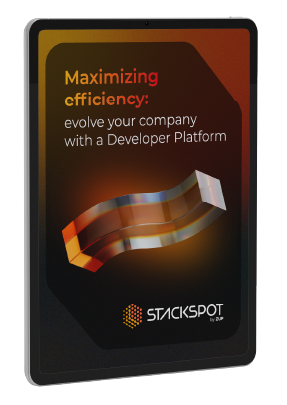Banking technology is advancing at an unprecedented pace, making it challenging to keep up. Staying ahead of the curve and adhering to best practices are essential for sustainable growth. With Infrastructure as Code (IaC), forward-looking development becomes not just achievable but also seamless and efficient.
IaC development practices serve as potent tools for financial services, bolstering clarity, consistency, reliability, and process optimization. Delving into the technical realm, let’s unravel how these transformative techniques are revolutionizing the landscape of banking development.
The Transformative Role of Infrastructure as Code in Banking
The drive for enhanced development practices comes from all corners. In 2024, 71% of consumers favored digital account management. About 89% of banking executives say their technology architectures determine their ability to create business value. The rapid evolution of technology demands sustained planning and agility.
Infrastructure as Code (IaC) brings a structured approach to overseeing infrastructure. It simplifies the process of deploying, managing, and scaling infrastructure through the utilization of code.
Real-world application of Infrastructure as Code (IaC)
Picture this scenario: Your team of developers is tasked with creating a cutting-edge consumer investment app poised to serve a vast user base in the cloud. Rather than laboriously setting up each cloud server individually, they opt for an Infrastructure as Code (IaC) approach.
In this method, your engineers craft an infrastructure configuration file serving as a blueprint for the cloud deployment process. This comprehensive template encompasses all the necessary cloud settings, enabling the seamless and automatic deployment of new servers with minimal effort and maximum efficiency.
Unlocking Transformative Advantages for the Banking Sector
While the scenario presented is hypothetical, it vividly showcases the limitless possibilities. Banks leveraging Infrastructure as Code (IaC) practices not only envision but also achieve mission-critical operational objectives, paving the way for more agile development.
- IaC helps banks limit IT outlay. Gartner forecasted that banking and investment services would spend $651 billion globally on IT in 2023. Other estimates say banks spend around 8% of their revenue on IT. IaC dramatically reduces labor costs to make IT more affordable.
- Infrastructure as Code keeps banks competitive by speeding deployment. Reusable infrastructure makes everyday tasks faster. Teams can work more efficiently, leaving more time for innovation.
- IaC reduces risk by promoting known best practices. IaC helps you enforce configurations you’ve already verified. It also lays the groundwork for automation that reduces human-introduced configuration errors. Considering that misconfiguration causes 35% of incidents and 20% of data breaches, this is an undeniable benefit.
Reshaping Development Processes
Infrastructure as Code goes deeper than just optimizing how you manage configs. It represents a wholesale evolution of your engineering lifecycle.
One of the significant advantages of IaC is idempotency. This is the idea that applying the same configurations multiple times should produce the same results.
The fast pace of development in financial institutions can often lead to configuration drift. Treating infrastructure as code allows you to reapply configs and restore a working base state on demand. Developers no longer have to waste time retracing their steps.
IaC practices inherently create breadcrumb trails for easier rollbacks and analysis. Templates are just files. Your team can track them in version control systems like any other code.
Leveraging the power of Infrastructure as Code doesn’t require specialized software. In fact, the developer tools you’re already familiar with, such as Git and documentation generators, are more than capable of handling the heavy lifting.
Consume innovation, begin transformation
Subscribe to our newsletter to stay updated on the latest best practices for leveraging technology to drive business impact
Security and Compliance in IaC: Banking on Reliability
Infrastructure as Code operates as a fluid engineering pattern, offering flexibility in designing infrastructure. While there are some limitations on the content of your templates, the framework allows for dynamic and adaptable configurations.
IaC configs can contain scripts and composable plugins that automate safety procedures. For instance, you might include directives that tell Kubernetes plugins to conduct custom security checks. You can also audit your templates themselves, uncovering hazards before deployment. Depending on how you set up your infrastructure, you can enforce many compliance and governance tasks you currently spend hours on.
Another major shift is that IaC promotes immutable infrastructures. When you want to change resources, you don’t need to tweak them directly. You just replace the entire state by iterating on and applying the configs. This high-level perspective helps engineers maintain reliability and avoid unintended side effects.
Collaborative DevOps: Powering Banking Workflows With Infrastructure as Code
Idempotency and immutability make collaboration easier. With Infrastructure as Code, teams no longer need to reconcile conflicting infrastructure states as they make changes. Instead, they rely on a single configuration file as the definitive source of truth.
This uniformity is every engineer’s dream, but it’s even better for the banking industry. Leading banks commonly split their engineering workforces into autonomous teams. This separation of roles can both solve problems and hinder alignment. However, with Infrastructure as Code (IaC), distributing work becomes seamless without additional hurdles.
Moreover, IaC’s collaborative nature serves as a bridge between developers and operations teams. For instance, if technical support identifies a persistent bug, examining a shared configuration could enable them to provide more insightful feedback to the engineers.
How StackSpot Enhances the Infrastructure as Code Experience
While Infrastructure as Code holds immense potential, it’s essential to recognize that it’s not a magical solution. The manner in which you implement these practices greatly influences their effectiveness. To reap the maximum benefits, it’s crucial to adopt a comprehensive and transparent framework.
StackSpot provides a robust ecosystem tailored for deploying and managing applications efficiently. By optimizing the Infrastructure as Code experience, StackSpot significantly reduces barriers to entry for financial institutions across all maturity levels.
Start Innovating Faster With Shared Infrastructure
With StackSpot, you can leverage infrastructure Plugins to effortlessly create and publish Infrastructure as Code (IaC) code. Rather than starting from scratch, you gain a head start with reusable building blocks, streamlining the development process.
Whether you prefer working in your preferred Command Line Interface (CLI) mode or a user-friendly Graphical User Interface (GUI), StackSpot offers flexibility to suit your preferences.
Boost Productivity With StackSpot AI Assistant
StackSpot’s AI Assistant empowers engineers to produce high-quality code with minimal effort. Through hyper-contextualized suggestions, it reduces errors and provides more pertinent insights. This leads to more effective and consistent configurations, enhancing overall productivity and reliability.
Comprehensive, Customizable Developer Environments
At the core of StackSpot’s offerings lie the Enterprise Developer Platform (EDP), Cloud Services, and AI capabilities, all deeply rooted in the Infrastructure as Code (IaC) philosophy. Engineers can seamlessly configure bespoke Actions, Plugins, infrastructure, and applications using simple YAML syntax. Additionally, StackSpot enables the creation of declarative hooks and the composition of flexible custom actions, empowering teams to tailor their workflows precisely to their needs.
Conclusion
Infrastructure as Code is revolutionizing banking development by fostering efficiency, scalability, and reliability, all of which are crucial for maintaining competitiveness in today’s market. So, why aren’t you leveraging its benefits?
StackSpot distinguishes itself among developer ecosystems because it doesn’t limit your Infrastructure as Code capabilities to the boundaries of its platform and frameworks. Whether you’re just starting out or well into your project timeline, StackSpot ensures streamlined processes and heightened security. To learn more, reach out to one of our experts today.











